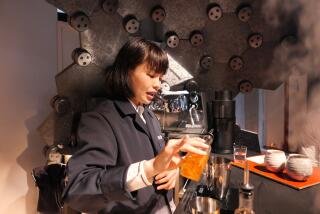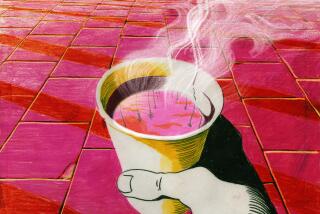The Coffee Revolution : Cupping: An Introduction
- Share via
For coffee lovers, the equivalent of a wine tasting is a cupping. The following instructions are adapted from Tim Castle’s “The Perfect Cup: A Coffee-Lover’s Guide to Buying, Brewing and Tasting” (Aris/Addison Wesley, 1991: $10.95).
For a tasting of three coffees, using three tasters, you will need:
* 9 (6-ounce) cups
* 3 tablespoons whole beans of each of three different coffees
* 1 quart cold water
* 3 soup spoons
* 3 note pads and pens
Line up three cups in front of each taster on a kitchen table near the sink for spitting. Grind each of the three coffees separately to the coarseness of cornmeal. Place one teaspoon of each coffee in one of each taster’s cups, and stick a piece of paper under each cup, noting which coffee is in it.
Boil the water (the ideal temperature is 210 degrees) and fill each cup to just below the rim. Allow the coffees to cool for a minute or two. Place your nose close to the cup and with the edge of a spoon gently break the crust that has formed on the surface. (“It makes surprisingly little difference how long it steeps before you break the crust,” says Castle. “We cup till the coffee’s cold.”)
At this point you will get your first impression of the coffee’s full aroma. Take a few sniffs (not many, or your sense of smell will be overloaded). You can pour a spoonful past your nose for a clearer scent, though you may get your nose wet. Concentrate on the impression of the aroma and write the most precise brief description you can give. Rinse your spoon between coffees, and be careful not to stir at this point.
When the coffees have cooled to the point where they won’t scald the tongue, clear away any floating grounds (there will be more with light roasts than dark roasts) with your spoon. Dip the spoon into the cup and slurp coffee forcefully from the spoon’s edge, spraying the inside of your mouth with coffee. The point is to let every part of the tongue give an instantaneous reading on the taste of the coffee. The back of the tongue detects bitterness or acidity, the sides are sensitive to staleness, and specific flavors may show up on the tip.
At the same time you will be able to reassess the aroma. Spit the coffee into the sink and sum up your reactions on the note pad. You should be paying attention to acidity (lower acidity is mellow; higher acidity is bright; the extremes are flat and acid); flavor (aroma and other specific qualities such as spiciness or mustiness), and body (an impression of weight and texture--heavy, light, rough, watery).
Repeat with each of the other coffees.
Note: Castle ideally recommends the burr-type grinder, available in electric and hand-cranked models. The usual electric coffee grinder, which has rotating blades, can’t produce an even grind. As a result, the larger particles of coffee don’t give up all their flavor to the brew and the smaller ones add a bitter, woody flavor. Unfortunately, electric burr-type grinders, though convenient, are expensive, and many have rather small burrs that may heat during grinding and change the taste of the coffee.
More to Read
Eat your way across L.A.
Get our weekly Tasting Notes newsletter for reviews, news and more.
You may occasionally receive promotional content from the Los Angeles Times.










